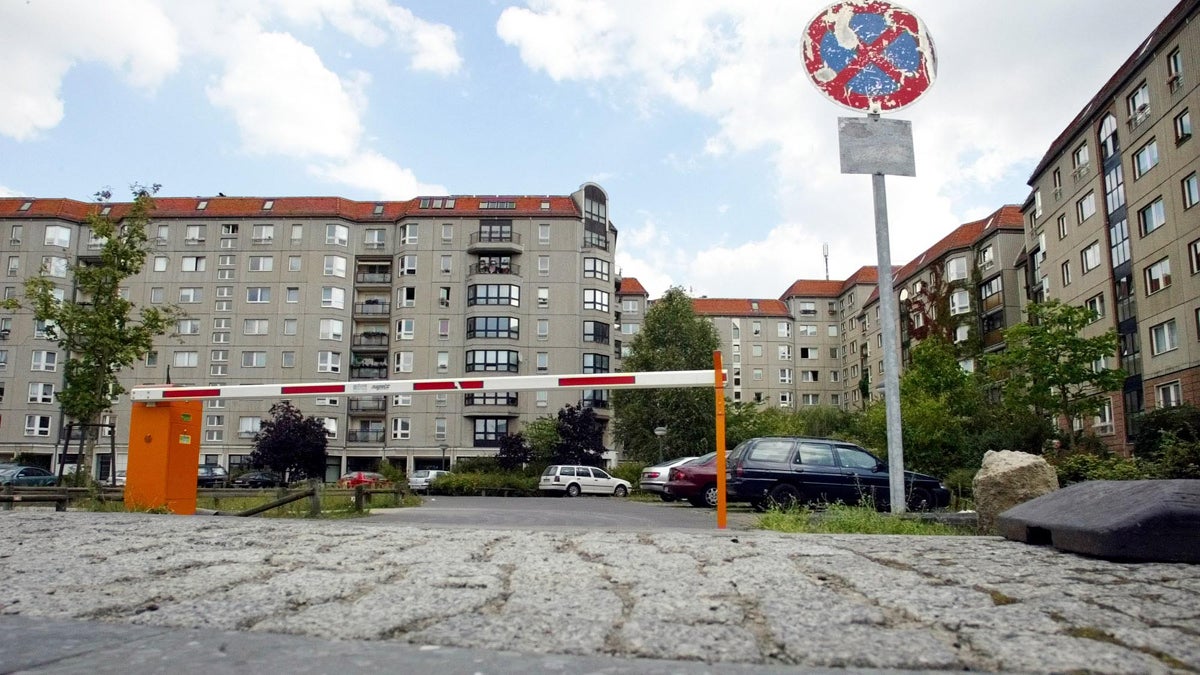25 years after Berlin Wall’s end, remembering a rough re-unification

There is nothing at this parking lot and housing area in Berlin, shown in 2004, to remind a visitor that this is the site of Adolf Hitler's bunker. After WWII, East Germany built up a housing area on the site. (AP Photo/Fritz Reiss)
As we mark the 25th anniversary of the Berlin Wall’s demise, I often think back to the first time I visited the newly re-unified Germany. Coming to terms with post-1989 Germany has not been simple for its residents. And just when I think I understand it, I remind myself how complex the layers of life in East Germany were.
It was 1991, two years after the fall of the Berlin Wall, when my husband and I first visited the newly re-unified Germany.
I had lived in a divided Germany for 15 years until 1984. It felt strange to cross from West to East Berlin unfettered by barbed wire and armed guards. And it was curious to see West German luxury Mercedes driving alongside sputtering East German Trabants, to observe how Western goods were gradually changing the face of the East. This year, as we mark the 25th anniversary of the wall’s demise, I often think back to that trip.
After visiting the renovated Reichstag, we mapped our way to the next destination. It looked like a straight line and an easy 20-minute walk. But when I asked a German official in the Reichstag to confirm our path, he strongly advised against walking and instead recommended a convoluted route on public transportation. He could give no reason other than it would be more comfortable.
Ignoring his advice, we walked the shorter path and found ourselves in an undeveloped area of no man’s land, where part of the Berlin wall had previously stood. It seemed that the two Germanys hadn’t yet determined what to do with this gaping hole in an otherwise densely populated city.
Then we saw a mound topped by odd-looking knee-high wires, each with a small white flag. There was no sign, nor did there seem to be a pattern to the wires. It was a mystery until we consulted guidebooks and checked with a couple of others exploring this moonscape. It seems we had unwittingly happened upon the site of Hitler’s secret bunker. And the newly unified Germany could not agree on what to do with it.
A nation of two minds
The country was still searching for ways to come to terms with its past. And I was still searching for ways to break through my own ambivalence about the unification of this country with its strange, checkered history. My feelings peak every November 9th, when I think of my German friends and colleagues, for whom the date is uncanny. Not only did the Berlin Wall fall on this date, but November 9 marks the oscillating pulse of 20th century Germany — the end of their monarchy and start of a democracy (1918), Hitler’s attempted overthrow of the democracy (1923), and then “Kristallnacht,” the Nazis’ pogrom against Jews (1938) all occurred on the same date.
After studying, researching and working in Germany for 15 years, I often wondered if my own ambivalence about Germany mirrored the extreme swings in the nation’s past. Doubt certainly drove my hesitant reaction to unification. And for those Europeans who had suffered under the Nazis, unification was a frightening prospect. In fact, for other reasons, not all Germans themselves embraced unification unconditionally.
During this trip to Berlin, I saw first-hand how unsettled the unification process was. Generations of East and West Germans had lived under two antagonistic political systems — communism and capitalism. They had developed diametrically opposed perspectives on their history and on their proposed future, and it would take time for them to find their way together.
Many in the West thought that the East Germans would eagerly drop their way of life and quickly adapt to Western ideals. Imagine their surprise when many Easterners developed nostalgia for their former country, a nostalgia so common that it now even has a label: Ostalgie (“nostalgia for the East”).
Post-1989 Germany
And when I thought longer about Ostalgie, it made sense. I began to see that some Easterners were missing a sense of community, while conveniently forgetting the oppression they had lived under. Perhaps they were also missing a sense of self-value. After 1989, the West invested heavily in the East’s infrastructure — to the resentment of many in the East. They were getting a handout and were expected to show gratitude to the very Westerners who laughed at their tastes and lifestyles. West Germans often belittled their East German cousins as country bumpkins, while the Easterners scorned their Western brethren as crass materialists.
Coming to terms with post-1989 Germany has not been simple for its residents, particularly for those in the East. In recent films and books, I have found myself transported back to East Germany, smelling its unique mustiness, seeing its muted colors, feeling its stodginess, and hearing the pervasive caution in everyone’s language. And just when I think I understand it, I remind myself how complex the layers of life in East Germany were.
We have seen Germany move through the 20th century as if on a seesaw, teetering from one November 9th to another. And every year on this date I ponder the lives of the many Germans I have known in both East and West, as I think about their attempts to stabilize history’s flow on their terms. It remains to be seen which of them will take charge of their lives, and which of them will suffer whiplash.
WHYY is your source for fact-based, in-depth journalism and information. As a nonprofit organization, we rely on financial support from readers like you. Please give today.

